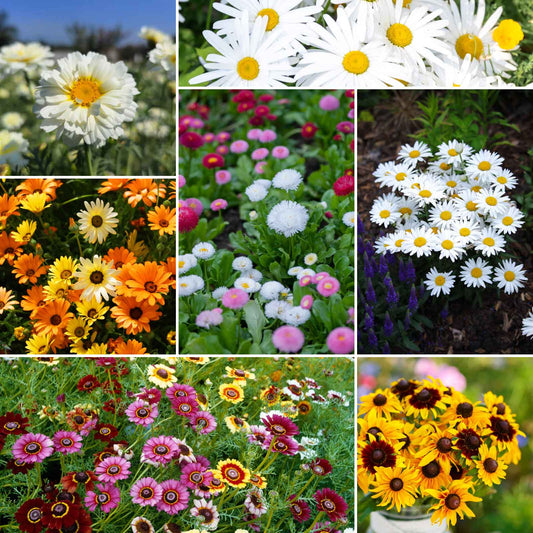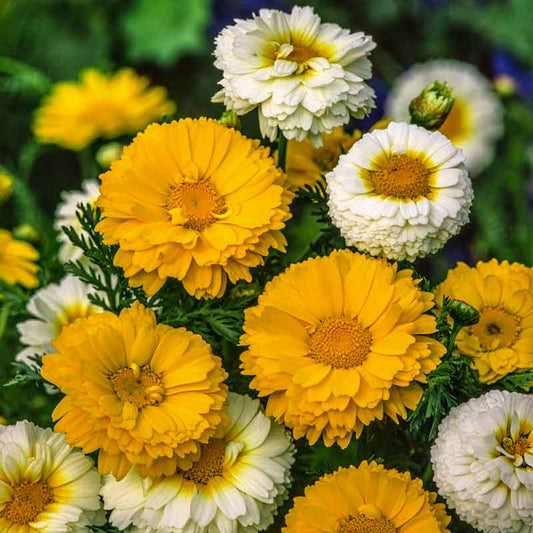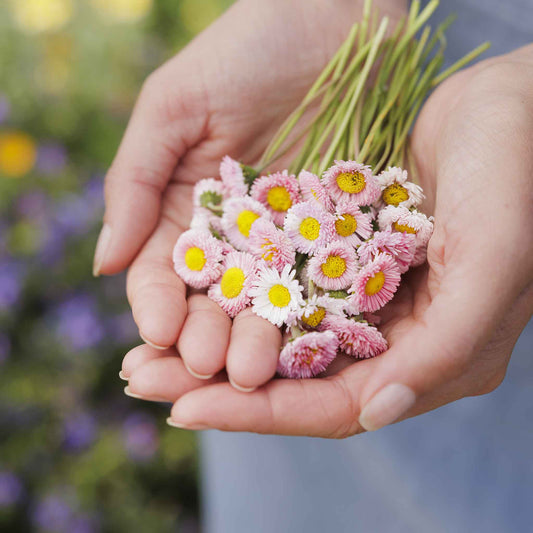-
main-collection-product-grid

Daisy Seeds - Shasta
The quintessential perennial daisy is an iconic cut flowerDaisy Seeds - Shasta
The quintessential perennial daisy is an iconic cut flowerRegular price As Low As $4.99Regular priceUnit price per -
main-collection-product-grid

Daisy Seeds (Painted) - Robinsons Giant Mix
Our horticulturist's go-to daisies for their crazy fun personalityDaisy Seeds (Painted) - Robinsons Giant Mix
Our horticulturist's go-to daisies for their crazy fun personalityRegular price As Low As $5.99Regular priceUnit price per -
main-collection-product-grid

Daisy Seeds (Painted) - Rainbow Mix
The go-to daisy for a kid's gardenDaisy Seeds (Painted) - Rainbow Mix
The go-to daisy for a kid's gardenRegular price As Low As $4.99Regular priceUnit price per -
main-collection-product-grid

Daisy Seeds - Creeping Daisy
Diminutive plants ideal for ground cover or bordersDaisy Seeds - Creeping Daisy
Diminutive plants ideal for ground cover or bordersRegular price As Low As $4.99Regular priceUnit price per -
main-collection-product-grid

Daisy Seeds - Ox-Eye
There's hardly a more symbolic summer flowerDaisy Seeds - Ox-Eye
There's hardly a more symbolic summer flowerRegular price As Low As $4.99Regular priceUnit price per -
main-collection-product-grid

Daisy Seeds (Ice Plant) - Livingstone Mix
Hardy, drought-tolerant plants make a vibrant groundcoverDaisy Seeds (Ice Plant) - Livingstone Mix
Hardy, drought-tolerant plants make a vibrant groundcoverRegular price As Low As $4.99Regular priceUnit price per -
main-collection-product-grid

Daisy Seeds (Shasta) - Crazy Daisy
Feathery flowers that are delightfully eccentricDaisy Seeds (Shasta) - Crazy Daisy
Feathery flowers that are delightfully eccentricRegular price $6.99Regular priceUnit price per -
main-collection-product-grid

Daisy Seeds (Paper) - Giant Flowered Mix
Pink, papery petals make perfect dried flower arrangementsDaisy Seeds (Paper) - Giant Flowered Mix
Pink, papery petals make perfect dried flower arrangementsRegular price As Low As $4.99Regular priceUnit price per -
main-collection-product-grid

Daisy Seeds (Painted) - Dunnetti Mix
These vibrant perennial blooms could stand in for zinniasDaisy Seeds (Painted) - Dunnetti Mix
These vibrant perennial blooms could stand in for zinniasRegular price As Low As $4.99Regular priceUnit price per -
main-collection-product-grid

Daisy Crazy - Daisy Flower Seed Mix
We're obsessed with all these fun variations of traditional daisiesDaisy Crazy - Daisy Flower Seed Mix
We're obsessed with all these fun variations of traditional daisiesRegular price As Low As $16.99Regular priceUnit price per -
main-collection-product-grid

Daisy Seeds (Ice Plant) - Livingstone Pastel Mix
Soft, muted blooms appear frosted in iceDaisy Seeds (Ice Plant) - Livingstone Pastel Mix
Soft, muted blooms appear frosted in iceRegular price As Low As $4.99Regular priceUnit price per -
main-collection-product-grid

Daisy Seeds (Shasta) - Silver Princess
Known as a prolific bloomer and vigorous grower in all hardiness zonesDaisy Seeds (Shasta) - Silver Princess
Known as a prolific bloomer and vigorous grower in all hardiness zonesRegular price As Low As $4.99Regular priceUnit price per -
main-collection-product-grid

Cape Daisy Seeds - Ballade Mix
Great garden pollinatorCape Daisy Seeds - Ballade Mix
Great garden pollinatorRegular price $8.99Regular priceUnit price per -
main-collection-product-grid

Daisy Seeds - Garland Double Mix
A late season bloomer, flowering summer into fallDaisy Seeds - Garland Double Mix
A late season bloomer, flowering summer into fallRegular price As Low As $4.99Regular priceUnit price per -
main-collection-product-grid

Daisy Seeds (African) - Mixed
Believe it or not, these vibrant, glimmering petals are undyedDaisy Seeds (African) - Mixed
Believe it or not, these vibrant, glimmering petals are undyedRegular price As Low As $4.99Regular priceUnit price per -
main-collection-product-grid

Daisy Seeds (Painted) - Polar Star
Let these snow-white blooms illuminate your moon gardenDaisy Seeds (Painted) - Polar Star
Let these snow-white blooms illuminate your moon gardenRegular price As Low As $4.99Regular priceUnit price per -
main-collection-product-grid

Daisy Seeds - German Flag
Whatever your heritage, these bold blooms will make you proudDaisy Seeds - German Flag
Whatever your heritage, these bold blooms will make you proudRegular price As Low As $4.99Regular priceUnit price per -
main-collection-product-grid

English Daisy Seeds - Pomponette Mix
Diminutive pom-pom shaped flowers blooming in cheerful shades of pink and whiteEnglish Daisy Seeds - Pomponette Mix
Diminutive pom-pom shaped flowers blooming in cheerful shades of pink and whiteRegular price $6.99Regular priceUnit price per -
main-collection-product-grid

Cape Daisy Seeds - Akila Hawaii Sunset Mix
Compact, well-branched, tight structure, covered in sunset colorsCape Daisy Seeds - Akila Hawaii Sunset Mix
Compact, well-branched, tight structure, covered in sunset colorsRegular price $8.99Regular priceUnit price per -
main-collection-product-grid

Gerbera Daisy Seeds - ColorBloom™ Mix
Part of the ColorBloom series bred for uniformity, quick to flower, and non-fading colorGerbera Daisy Seeds - ColorBloom™ Mix
Part of the ColorBloom series bred for uniformity, quick to flower, and non-fading colorRegular price $7.99Regular priceUnit price per -
main-collection-product-grid

Daisy Seeds (Painted) - Flame
Fiery crimson blooms seem to glow in the twilightOut of StockDaisy Seeds (Painted) - Flame
Fiery crimson blooms seem to glow in the twilightRegular price As Low As $5.49Regular priceUnit price per
Growing daisies in your yard
- 21 daisy seed varieties
- Daisies are easy to grow, fun-loving flowers
- Attracts pollinators
- Prefers full sun exposure
growing your own daisies from seed
Over time, daisies have become one of the most commonly recognized flowers in existence. Chaucer called it "eye of the day". The name "daisy" is considered by many to be a corruption of "day's eye", the reason being that the entire head closes at night only to open again the following morning. Native to central, western, and northern Europe, the daisy has become widely naturalized in most temperate regions, including the Americas where it is widely used as ground-cover.
The multiple uses of daisy blooms
Though no introduction is needed, not everyone knows that much about daisies. Traditionally used for making daisy chains for children, there is so much more to this cheerful flower. They are perennial herbaceous plants that are not just pretty, but edible! The young leaves can be prepared and eaten in salads, or cooked. Flowers are often eaten in salads or used as decoration on cakes. When grown under the ideal situations, daisies have an incredibly long flowering season, sometimes even producing a flower or two in the winter. There are almost endless varieties to choose from, meaning there is a daisy for even the most particular gardener.
daisy seed germination
Adding to their appeal, daisies are well-known for being almost foolproof to grow. Plant them in the spring, summer, or fall in a sunny area with well-draining soil. Because they are so easy to grow, most gardeners simply sow the seeds directly in the garden. Simply prepare the soil by using a rake or a hoe to scratch the top of the soil. Then, toss the seeds on top of the soil, only lightly covering with about 1/8th an inch of soil. While the seeds are germinating, it is important to maintain a good level of moisture. The germination period is typically 14 days. If desired, a general fertilizer can be applied in the early growing stages, and monthly thereafter. For bigger, brighter flowers, you can switch to a high phosphorus fertilizer before the daisies bloom.
Once established, you can separate your varieties by division every three to four years to avoid overcrowding. If you live in a cold climate, give your daisies a layer of winter protection with mulch.
For more information about planting, growing, and caring for daisies, see the Daisy Seeds Planting Guide.




















